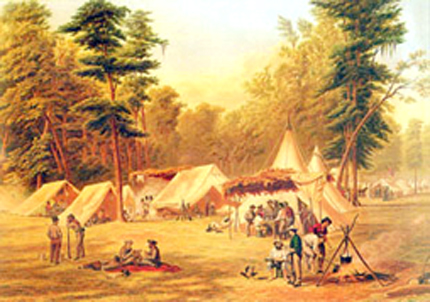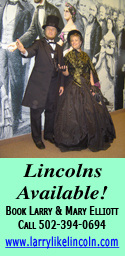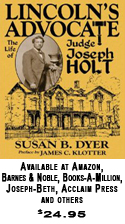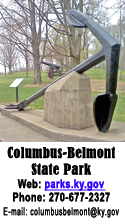|
Kentucky soldier’s Civil War painting
can be purchased for mere $500,000
Sometimes, you just don’t know the value of what you have.
Leo Oaks of Grants Pass, Ore., discovered that recently when an oil painting turned up from the clean out of an old shed.
The Civil War book collector thought something looked familiar about the oil-on-canvas painting and bought it for $25. Later, when he removed the backing from the artwork, he discovered what was written on its back – “Camp of the 3rd Kent.,nr. Corinth, Miss. May 11th 1862. Painted by C.W. Chapman Co. D.”
 The artist was Conrad Wise Chapman, well known for his Civil War pictures and Mexican landscape scenes. It turned out that the image was one that made Chapman famous and was valued at $1,600, according to a Philadelphia website. Oaks, however, because of the rarity of the piece, has offered to sell it for $500,000. Few, if any, original Chapman Civil War paintings are on the market. The artist was Conrad Wise Chapman, well known for his Civil War pictures and Mexican landscape scenes. It turned out that the image was one that made Chapman famous and was valued at $1,600, according to a Philadelphia website. Oaks, however, because of the rarity of the piece, has offered to sell it for $500,000. Few, if any, original Chapman Civil War paintings are on the market.
“I don’t give a hoot whether I sell it or not,” Oaks confesses. “I really enjoy the painting. It’s a national treasure.”
The way the painting resulted and how Chapman came to be a member of the 3rd Kentucky Confederate Infantry is a story in itself.
The Washington, D.C., native grew up in Europe where his father – John Gadsby Chapman – was working as an artist.
When news of the Civil War reached Conrad Chapman in Rome, he rushed to join the Confederacy. Unable to get to Virginia, he enlisted in the Kentucky regiment, and, during the battle of Shiloh (April 6-7, 1862), he suffered a serious head injury. After the battle, Confederate forces retreated to Corinth, Miss., the site of the artist’s painting. Chapman probably was recovering from his wound when he painted the scene about a month after Shiloh.
The painting depicts Company D in camp at Corinth, and Chapman – in the lower left of the artwork – is included in a self-portrait as the solitary soldier leaning on a rifle and talking with a water carrier.
The 3rd Kentucky was organized in July 1861 at Camp Boone, Tenn., under the command of Col. Lloyd Tilghman of Paducah. The 3rd later was ordered to reinforce the defenses of Vicksburg, Miss.
Later in 1862, Chapman was transferred to a Virginia regiment, mostly at the request of his well-connected father, who wanted him out of the line of fire and into a staff position. Transferred to Charleston, S.C., he was assigned to sketch war scenes and weaponry. A series of 31 oils of Charleston, based on Conrad’s sketches and with some completed by his father, are hanging in the Museum of the Confederacy at Richmond, Va.
In 1864, Conrad was furloughed for six months and traveled to Italy. After the end of the war, unable to reconcile the Confederacy’s loss, he traveled to Mexico for a short while. Later, he painted in Rome, Paris, London, Mexico and New York, but struggled with ill health and poverty. He was living in Hampton, Va., at the time of his death.
John Chapman, who taught Conrad and another son – John Linton – to paint, was a well-respected artist. His painting, “The Baptism of Pocahontas,” was placed in the U.S. Capital rotunda in 1840.
In 1863 in Charleston, Conrad painted another successful work, the Confederate submarine H.L. Hunley, one of the first submarines used successfully in warfare. That painting depicts the boat’s inventor (H.L.Hunley) leaning against the vessel, conversing with a sentinel.
Several of Conrad’s Mexican paintings brought five- and six-figure prices at auction. Two scenes, Texcoco and Valle de México, each brought $63,000 and a Mexican Landscape sold for $123,5000.
|

















 The artist was Conrad Wise Chapman, well known for his Civil War pictures and Mexican landscape scenes. It turned out that the image was one that made Chapman famous and was valued at $1,600, according to a Philadelphia website. Oaks, however, because of the rarity of the piece, has offered to sell it for $500,000. Few, if any, original Chapman Civil War paintings are on the market.
The artist was Conrad Wise Chapman, well known for his Civil War pictures and Mexican landscape scenes. It turned out that the image was one that made Chapman famous and was valued at $1,600, according to a Philadelphia website. Oaks, however, because of the rarity of the piece, has offered to sell it for $500,000. Few, if any, original Chapman Civil War paintings are on the market.